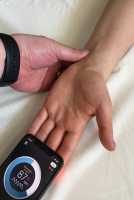03 Apr Smartphone App Bests Clinical Assessment of Blood Flow
MedicalResearch.com Interview with:
Benjamin Hibbert MD PhD FRCPCz
Interventional Cardiologist
Clinician Scientist and Assistant Professor
CAPITAL Research Group
Vascular Biology and Experimental Medicine Laboratory
University of Ottawa Heart Institute
MedicalResearch.com: What is the background for this study? What are the main findings?
Response: When we designed the study in 2014 we were routinely using the modified allen’s test (MAT) to screen patients for transradial access for coronary angiography and PCI. We all had iPhones and we started using the HeartRate monitoring application as a photoplethysmograph. Quite quickly we found that using the application was simple, worked well and because we always had our iPhone with us we tended to use it more often. That being said – we wanted to test it in a scientifically rigorous method and thus we elected to perform an RCT to evaluate it’s diagnostic accuracy.
 The current study is the first to use the photoplethysmographic capabilities of smartphones to assess blood flow – in this case in the hand to assess for blockages in arteries before accessing them for a procedure. The hand is supplied by two arteries – the radial artery and the ulnar artery. In many cases in medicine we use the radial artery, whether it be placing a catheter to monitor blood pressure, as a method of getting to the heart for angioplasty and in coronary artery bypass grafting it is removed and used as a bypass to restore blood flow to the heart. In many instances doctors assess the patency of the ulnar artery to decided if they are going to use the radial artery for a procedure – the concept being that if the ulnar is compromised and we use the radial then the hand can develop complications from not enough blood flow. To determine if a patient is eligible doctors would use a bedside physical exam test called the modified Allen’s test in which they occlude both arteries to cause the hand to turn white. They then release pressure on the ulnar letting blood only pass through this vessel to see if the hand turns pink. However, there is a lot of variability in what doctors consider to be abnormal and determining if the test is positive can depend on numerous factors including skin tone, the amount of pressure applied and the size of the vessels.
The current study is the first to use the photoplethysmographic capabilities of smartphones to assess blood flow – in this case in the hand to assess for blockages in arteries before accessing them for a procedure. The hand is supplied by two arteries – the radial artery and the ulnar artery. In many cases in medicine we use the radial artery, whether it be placing a catheter to monitor blood pressure, as a method of getting to the heart for angioplasty and in coronary artery bypass grafting it is removed and used as a bypass to restore blood flow to the heart. In many instances doctors assess the patency of the ulnar artery to decided if they are going to use the radial artery for a procedure – the concept being that if the ulnar is compromised and we use the radial then the hand can develop complications from not enough blood flow. To determine if a patient is eligible doctors would use a bedside physical exam test called the modified Allen’s test in which they occlude both arteries to cause the hand to turn white. They then release pressure on the ulnar letting blood only pass through this vessel to see if the hand turns pink. However, there is a lot of variability in what doctors consider to be abnormal and determining if the test is positive can depend on numerous factors including skin tone, the amount of pressure applied and the size of the vessels.
MedicalResearch.com: What should readers take away from your report?
Response: Using a smartphone to monitor changes in color in the finger tips (photoplethsymography) is much more accurate in detecting subtle changes as opposed to the doctors general opinion of the color of the hand. This resulted in doctors being able to more accurately determine if arteries were blocked – in the current study correctly classifying patients 10% more often than by the modified Allen’s test.
This is important for a few reasons – first, smartphones are widely available and the application is free. So this test can be used today at the bedside without buying any new equipment and without any additional cost to the health care system.
Second, by being more accurate this will enable doctors to more safely and accurately pick patients in whom they can use the radial artery for angioplasty or bypass – thus more patients will benefit from the optimal procedure.
Finally, this is proof of concept that using mobile health technology, in this case a smartphone based application, can accurately be used to assess blood flow.
MedicalResearch.com: What recommendations do you have for future research as a result of this work?
Response: While not tested in this study – future applications could be screening for other diseases of the blood vessels. In particular, peripheral arterial disease is notoriously difficult to detect by physical exam and relative differences in blood flow in the limbs assessed by a smartphone application could enable cost effective screening. Moreover, assessment of the microvasculature is something that is poorly done clinically. We’ve already started working on next generation software and designing studies to detect differences in the small vessels that can occur in diseases like diabetes.
No disclosures
Citations:
Photoplethysmography using a smartphone application for assessment of ulnar artery patency: a randomized clinical trial
Pietro Di Santo, David T. Harnett, Trevor Simard, F. Daniel Ramirez, Ali Pourdjabbar, Altayyeb Yousef, Robert Moreland, Jordan Bernick, George Wells, Alexander Dick, Michel Le May, Marino Labinaz, Derek So, Pouya Motazedian, Richard G. Jung, Jaya Chandrasekhar, Roxana Mehran, Aun-Yeong Chong and Benjamin Hibbert
CMAJ April 03, 2018 190 (13) E380-E388; DOI: https://doi.org/10.1503/cmaj.170432
[wysija_form id=”3″]
The information on MedicalResearch.com is provided for educational purposes only, and is in no way intended to diagnose, cure, or treat any medical or other condition. Always seek the advice of your physician or other qualified health and ask your doctor any questions you may have regarding a medical condition. In addition to all other limitations and disclaimers in this agreement, service provider and its third party providers disclaim any liability or loss in connection with the content provided on this website.
Last Updated on April 3, 2018 by Marie Benz MD FAAD

